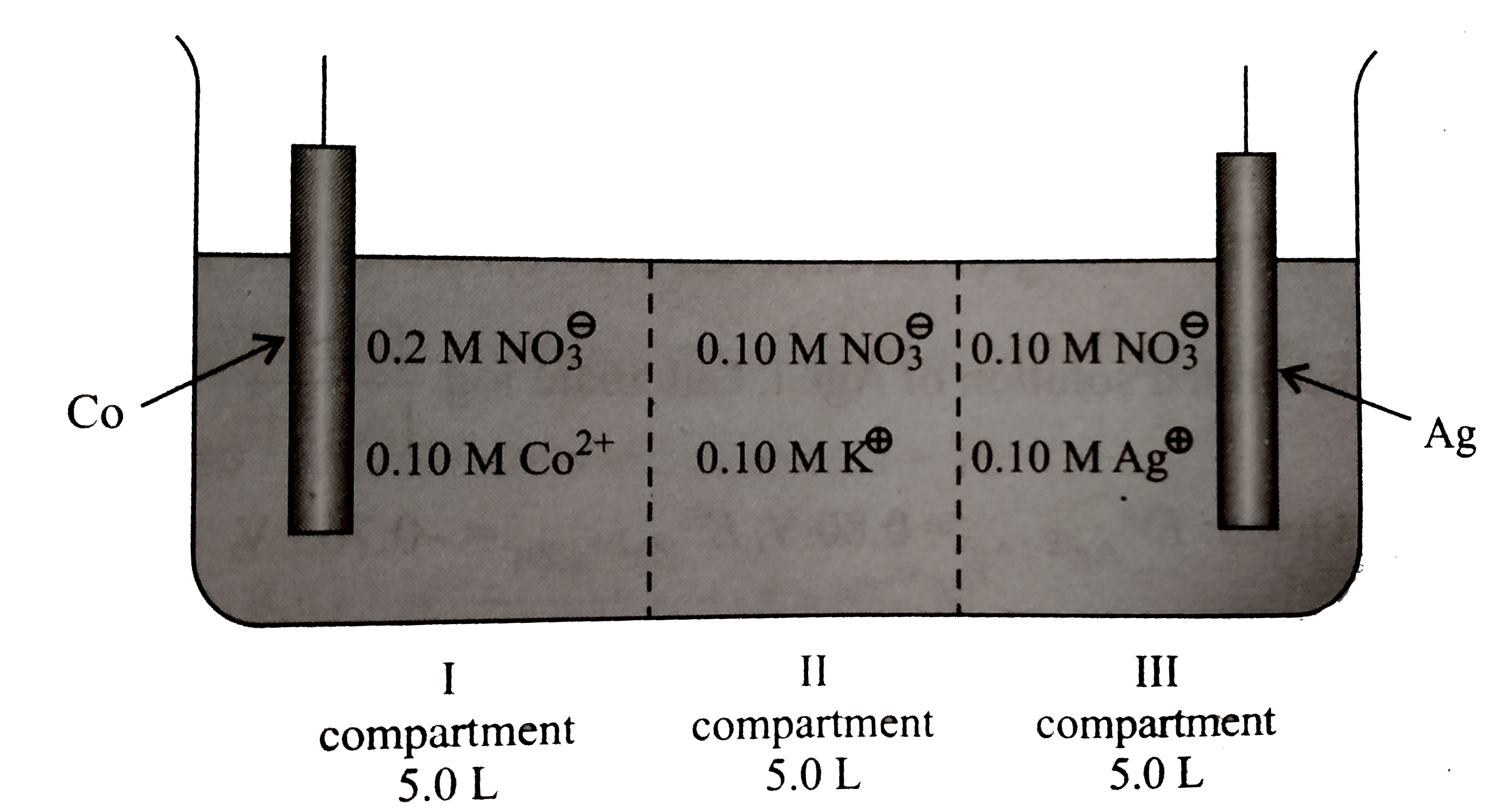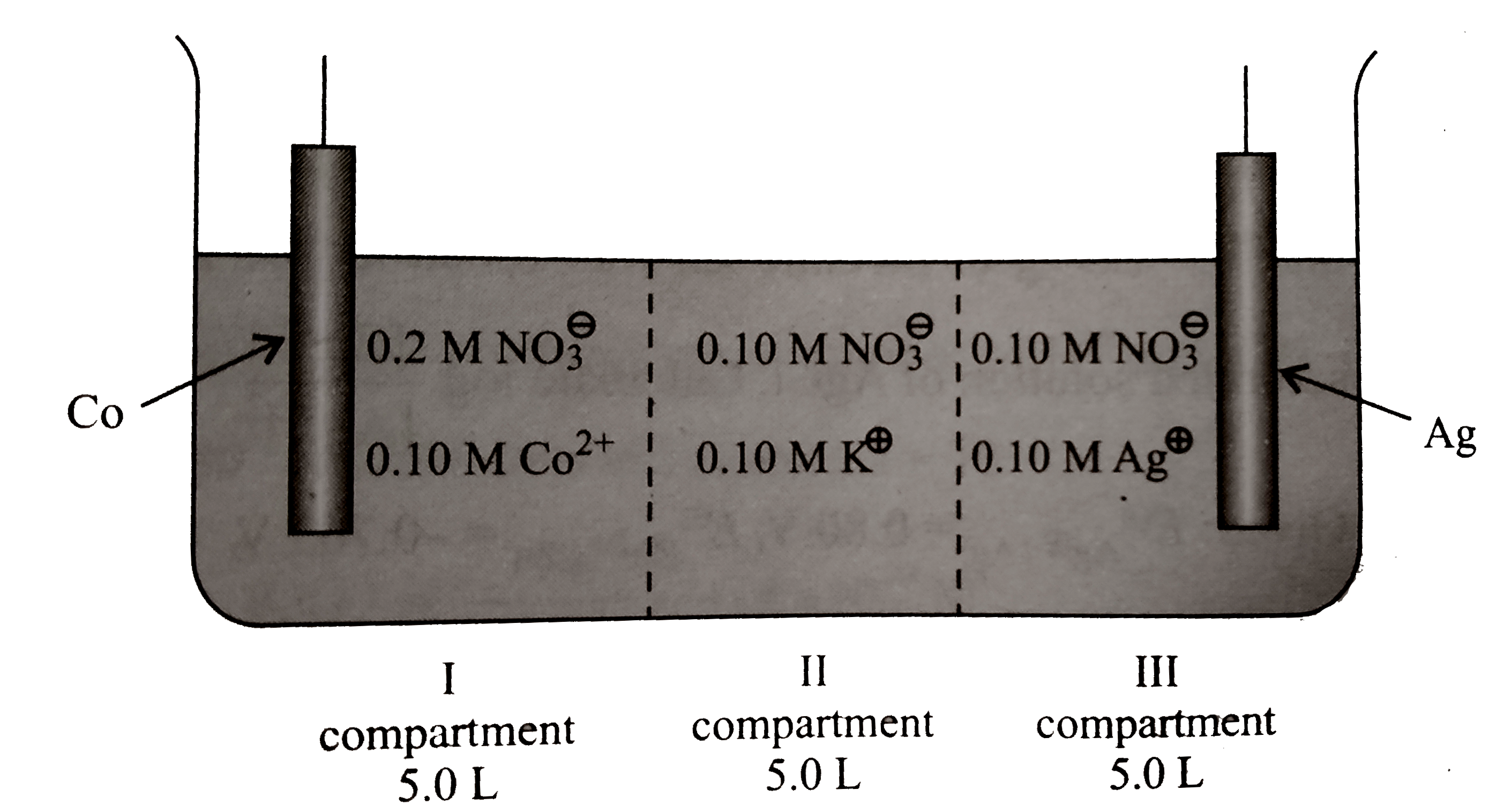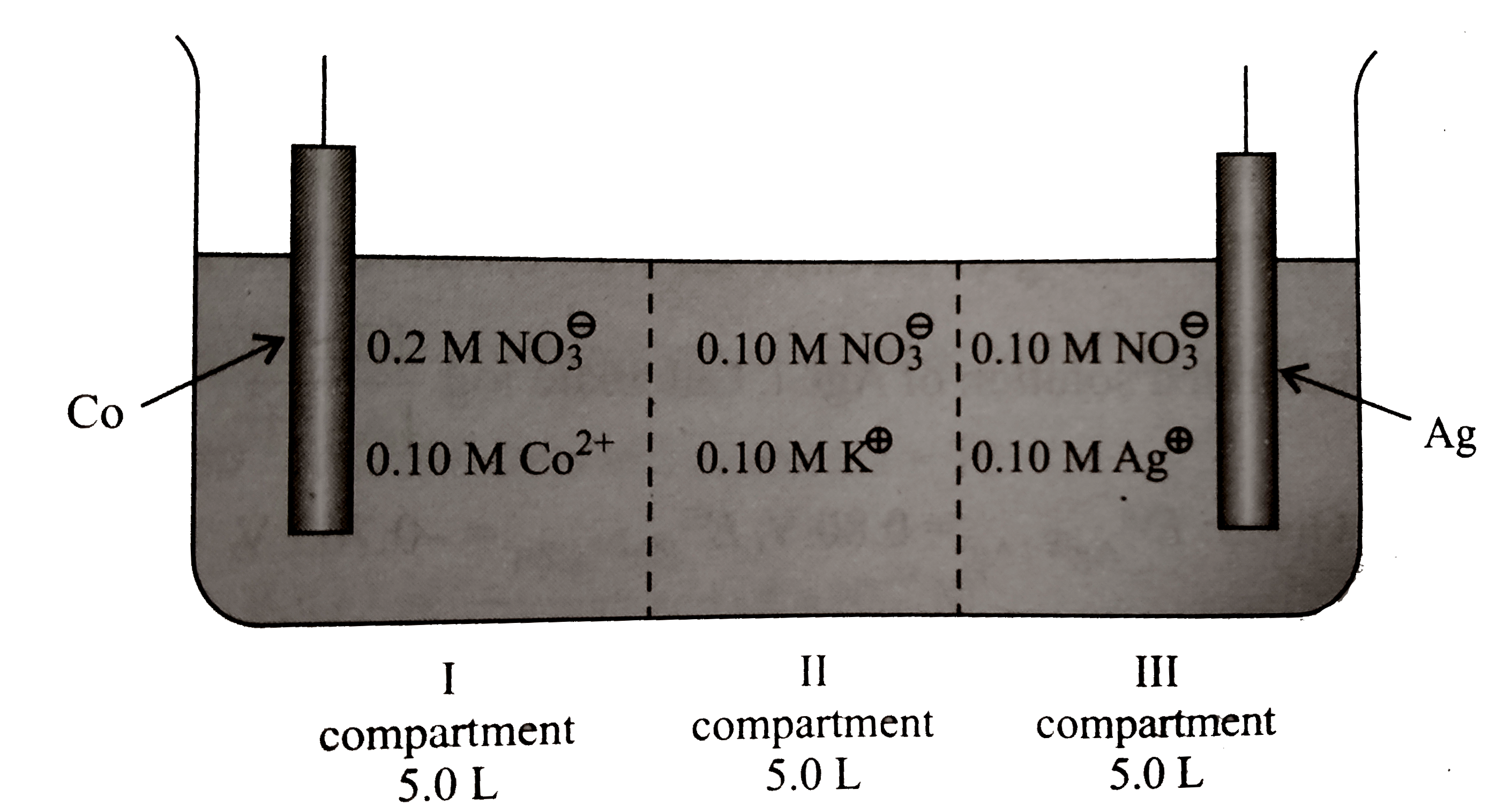A cell, as shown below, consists of there compartments separated by porous pots. The first contains a cobalt eletrode in 5.0L of 0.10MCo(NO3), the second contains 5.0L of 0.10MKNO3, the third contains an Ag electrode in 5.0L of 0.10MAgNO3. Assuming that current with in the cell iis carried equally by the negative and positive ions by passign 0.1F of electricity.

Given :Co2++2e−→Co Ec−=−0.28V
Ag⊕+e−→Ag Ec−=0.80V
2Ag⊕+CorarrCo2++2Ag Ec−.cell=1.08V
Finally the II compartment contains
I
I,II,
I,II,III
II,III,IV
The correct Answer is:d
Since Co2+ ions from I compartment do not move to III compartment, so Co2+ ions are not present there.
As explained in Question, there is a movement of NOc−3 ions, some concentration of NOc−.3 ions is left in III compartment. There is also a movement of K⊕ ions from II compartment to both I and III compartments.
There is decrease in positive charge due to reduction of Ag(⊕) to Ag in III compartment.
Hence, ions present in III compartment are:Ag⊕,NOc−3, and KO+.
Effect of electrode: Oxidation of Co to Co2+ at anode and reduction of Ag⊕ to Ag at cathode occurs by the passage of 0.1F of electricity.
Effect by the migration of ions through porous barries :
Since charge carried by positive or negative ions is equal therefore transport number of each ion is equal, i.e.,tc⊕=tac−=11+1=0.5 . Hence, number of ions transported from one compartment to another−0.5×0.1F=0.05Eq. 
Topper's Solved these Questions
- ELECTROCHEMISTRYBOOK - CENGAGE CHEMISTRY ENGLISHCHAPTER - ELECTROCHEMISTRYEXERCISE - Exercisemultiple Correct Ansers
53 Videos
- ELECTROCHEMISTRYBOOK - CENGAGE CHEMISTRY ENGLISHCHAPTER - ELECTROCHEMISTRYEXERCISE - Exercises Ingle Correct
178 Videos
- ELECTROCHEMISTRYBOOK - CENGAGE CHEMISTRY ENGLISHCHAPTER - ELECTROCHEMISTRYEXERCISE - Ex 3.3 (Objective)
10 Videos
- D AND F BLOCK ELEMENTSBOOK - CENGAGE CHEMISTRY ENGLISHCHAPTER - D AND F BLOCK ELEMENTSEXERCISE - Archives Subjective
29 Videos
- GENERAL PRINCIPLES AND PROCESS OF ISOLATION OF ELEMENTSBOOK - CENGAGE CHEMISTRY ENGLISHCHAPTER - GENERAL PRINCIPLES AND PROCESS OF ISOLATION OF ELEMENTSEXERCISE - Archives (Subjective)
14 Videos
Similar Questions
Consider the following concentration cell:
Zn(s)∣∣Zn2+(0.024M)∣∣∣∣Zn2+(0.480M)∣∣Zn(s)
which of the following statements is / are correct?
View SolutionWhich of the following solutions can be safely stored in a copper vessel ?
(a)ZnSO4
(b)AgNO3
(c)AuCl3
(d)All of them.
View SolutionArrange the following compounds in the order of increasing conductance :HCl,LiCl,NaCl,KCl.
View SolutionWhat happens when SO2 gas is bubbled through an aqueous solution of copper sulphate in the presence of potassium thiocyanate?
View SolutionWrite the chemical equations involved in the extraction of lead from galena by self-reduction process.
View SolutionA volataic cell consists of an electode of solide silver immerse in a 0.10MAgNO3 solution and an electrode of unknown metal 'X' immersed in a 0.10M solution X(NO3)2. A porous barrier separates the two half of the cell. Also given :
Ec−.(Ag⊕∣Ag)=0.80V and Ec−.cell=1.05V at 25∘C
X(s)∣∣X2+(1.0M)∣∣∣∣Ag⊕(0.1M)∣∣Ag(s)
Which of the following statements regarding the cell and X is incorrect?
View SolutionA volataic cell consists of an electode of solide silver immerse in a 0.10MAgNO3 solution and an electrode of unknown metal 'X' immersed in a 0.10M solution X(NO3)2. A porous barrier separates the two half of the cell. Also given :
Ec−.(Ag⊕∣Ag)=0.80V and Ec−.cell=1.05V at 25∘C
X(s)∣∣X2+(1.0M)∣∣∣∣Ag⊕(0.1M)∣∣Ag(s)
If Ag⊕∣Ag half cell in the above voltaic cell is replaced by Zn2+∣Zn half cell (Ec−.Zn2+∣Zn=−0.76V)
View SolutionA cell, as shown below, consists of there compartments separated by porous pots. The first contains a cobalt eletrode in 5.0L of 0.10M Co(NO_(3)), the second contains 5.0L of 0.10M KNO_(3), the third contains an Ag electrode in 5.0L of 0.10M AgNO_(3) . Assuming that current with in the cell iis carried equally by the negative and positive ions by passign 0.1F of electricity. Given : Co^(2+)+2e^(-) rarr Co" "E^(c-)=-0.28V Ag^(o+)+e^(-) rarr Ag" "E^(c-)=0.80V 2Ag^(o+)+Corarr Co^(2+)+2Ag" "E^(c-)._(cell)=1.08V Finally, the I compartment contains I. Co^(2+)" "II. NO_(3)^(c-)" "III.K^(o+)" "IV.Ag^(o+)
View SolutionA cell, as shown below, consists of there compartments separated by porous pots. The first contains a cobalt eletrode in 5.0L of 0.10M Co(NO_(3)), the second contains 5.0L of 0.10M KNO_(3), the third contains an Ag electrode in 5.0L of 0.10M AgNO_(3) . Assuming that current with in the cell iis carried equally by the negative and positive ions by passign 0.1F of electricity. Given : Co^(2+)+2e^(-) rarr Co" "E^(c-)=-0.28V Ag^(o+)+e^(-) rarr Ag" "E^(c-)=0.80V 2Ag^(o+)+Corarr Co^(2+)+2Ag" "E^(c-)._(cell)=1.08V Finally, the II compartment contains
View SolutionA cell, as shown below, consists of there compartments separated by porous pots. The first contains a cobalt eletrode in 5.0L of 0.10M Co(NO_(3)), the second contains 5.0L of 0.10M KNO_(3), the third contains an Ag electrode in 5.0L of 0.10M AgNO_(3) . Assuming that current with in the cell iis carried equally by the negative and positive ions by passign 0.1F of electricity. Given : Co^(2+)+2e^(-) rarr Co" "E^(c-)=-0.28V Ag^(o+)+e^(-) rarr Ag" "E^(c-)=0.80V 2Ag^(o+)+Corarr Co^(2+)+2Ag" "E^(c-)._(cell)=1.08V Finally the II compartment contains
View SolutionA cell, as shown below, consists of there compartments separated by porous pots. The first contains a cobalt eletrode in 5.0L of 0.10M Co(NO_(3)), the second contains 5.0L of 0.10M KNO_(3), the third contains an Ag electrode in 5.0L of 0.10M AgNO_(3) . Assuming that current with in the cell iis carried equally by the negative and positive ions by passign 0.1F of electricity. Given : Co^(2+)+2e^(-) rarr Co" "E^(c-)=-0.28V Ag^(o+)+e^(-) rarr Ag" "E^(c-)=0.80V 2Ag^(o+)+Corarr Co^(2+)+2Ag" "E^(c-)._(cell)=1.08V The final concentration of Co^(2+) in I, II, and III compartment is
View SolutionA cell, as shown below, consists of there compartments separated by porous pots. The first contains a cobalt eletrode in 5.0L of 0.10MCo(NO3), the second contains 5.0L of 0.10MKNO3, the third contains an Ag electrode in 5.0L of 0.10MAgNO3. Assuming that current with in the cell iis carried equally by the negative and positive ions by passign 0.1F of electricity.

Given :Co2++2e−→Co Ec−=−0.28V
Ag^(o+)+e^(-) rarr Ag" "E^(c-)=0.80V<br>2Ag^(o+)+Corarr Co^(2+)+2Ag" "E^(c-)._(cell)=1.08V<br>Thef∈alconcentrationofNO_(3)^(c-)∈I,II,andIII compartment is
View SolutionA cell, as shown below, consists of there compartments separated by porous pots. The first contains a cobalt eletrode in 5.0L of 0.10M Co(NO_(3)), the second contains 5.0L of 0.10M KNO_(3), the third contains an Ag electrode in 5.0L of 0.10M AgNO_(3) . Assuming that current with in the cell iis carried equally by the negative and positive ions by passign 0.1F of electricity. Given : Co^(2+)+2e^(-) rarr Co" "E^(c-)=-0.28V Ag^(o+)+e^(-) rarr Ag" "E^(c-)=0.80V 2Ag^(o+)+Corarr Co^(2+)+2Ag" "E^(c-)._(cell)=1.08V The final concentration of K^(o+) in I,II, and III compartment is
View SolutionA cell, as shown below, consists of there compartments separated by porous pots. The first contains a cobalt eletrode in 5.0L of 0.10MCo(NO3), the second contains 5.0L of 0.10MKNO3, the third contains an Ag electrode in 5.0L of 0.10MAgNO3. Assuming that current with in the cell iis carried equally by the negative and positive ions by passign 0.1F of electricity.

Given :Co2++2e−→Co Ec−=−0.28V
Ag^(o+)+e^(-) rarr Ag" "E^(c-)=0.80V<br>2Ag^(o+)+Corarr Co^(2+)+2Ag" "E^(c-)._(cell)=1.08VThef∈alconcentrationofAg^(o+)∈I,II,andIII compartment is
View SolutionThe cell consists of three compartments separated by porous barriers. The first contains a cobalt electrode in 5.00 L of 0.100 M cobalt (II) nitrate, the second contains 5.00 L of 0.100M AgNO3. Assuming that the current within the cell is carried equally by the positive and negative ions, tabulate the concentrations of ions of each type in each compartment of the cell after the passage of 0.100 mole electrons.
given Co2++2e−→Co E0=−0.28V
Ag++e−→Ag E0=0.80V
Spontaneous reaction is: 2Ag++CotoCo2++2Ag 1.08V
View SolutionA current is passed through two cells connected in series. The first cell contains X(NO3)3(aq) and the second cell contains Y(NO3)2(aq) . The relative atomic masses of X and Y are in the ratio 1:2. What is the ratio of liberated mass of X to that of Y ?
View Solution
